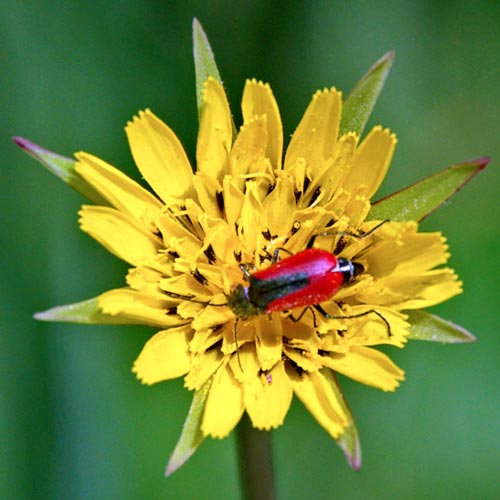Salutations, BugFans,
The BugLady had never heard of soft-winged flower beetles until she found these little guys with striped abdomens climbing around on prairie plants last summer, and she was happy to find another bunch of predators to admire. North America accounts for 500-plus species of often-strikingly-colored, slightly-hairy beetles in the family Melyridae (including a few that range almost to the Arctic Circle and there are more species throughout the world).
[metaslider id=4238]
Omnivorous adult Melyrids are often found on flowers out in the open, where they eat pollen, insect eggs, and flower-loving insects that land within their grasp. The larvae generally stay concealed under tree bark or leaf litter or soil, where they prey on other invertebrates.
Question: What attribute does some distant cousin Melyrids from the South Pacific share with poison dart frogs and, surprisingly, with a few species of birds in their New Guinea neighborhoods?
Answer: BTX, or batrachotoxins—potent heart and nerve toxins that strongly discourage predators. These strange bedfellows are believed to ingest toxins in something they eat and then secrete them. BTX is present in the skin and feathers of the birds that entertain it, and Melyrid beetles are probably their toxin/food source.
Attalus terminalis
Attalus terminalis, which apparently doesn’t have a common name other than the generic “Soft-winged flower beetle,” has a pretty ambitious genus name to live up to. It seems to be named after Attalus, one of a line of Greek rulers, soldiers, embroiderers, gardeners and botanists (sometimes simultaneously), mostly in the BCs. What an interesting bunch to name a half-inch beetle after!
The BugLady found ATs mentioned in transactions from various early entomological meetings including Kansas (1883–4), Philadelphia (1897—the Mount Washington list) and Wisconsin (1909). We do stand on the shoulders of the folks who walked before us. According to one source, ATs are found at the edges, where field meets forest. They are also on a list called “Rare or uncommon prairie-dependent insects known from or likely to be present in the proposed southwest Wisconsin Grassland and Stream Conservation area.”
Scarlet Malachite Beetle
The Scarlet Malachite Beetle (Malachus aenus), a much flashier member of the Melyridae family, can be seen on flowers in grasslands across the northern tier of the U.S. and southern tier of Canada. Accidentally or on purpose, it seems to have been introduced to North America at some time from somewhere in Eurasia. As one blogger points out, since they’re not crop pests, there’s not a lot of information out there about them. The BugLady did find reference to some SMB damage of young wheat in Canada which would seem to be at odds with their carnivorous reputation, though the SMB seems to lean more heavily toward pollen consumption than does AT.
In England, SMBs are on bug-lovers’ Most Wanted Lists. BugLife, the voice of the British Invertebrate Trust Fund, once named the SMB “Bug of the Month” and spearheads the “Scarlet Malachite Beetle Project” to raise public awareness. British on-line posts are divided between “Please report sightings of this rare beetle” and “Rare beetle spotted in Something-shire.” One theory is that it lays its eggs in thatched roofs, so people with thatched roofs are asked to be on the lookout for it (don’t snicker—a well-thatched roof lasts for 60 to 70 years and uses up a whole lot of Phragmites in the process). SMBs used to be common there, but now they are threatened with extirpation from Britain (completely gone from Britain but not extinct elsewhere).
Though SMBs are armed with Mother Nature’s warning colors, the BugLady didn’t find anything to indicate that they are toxic or distasteful.
The BugLady
